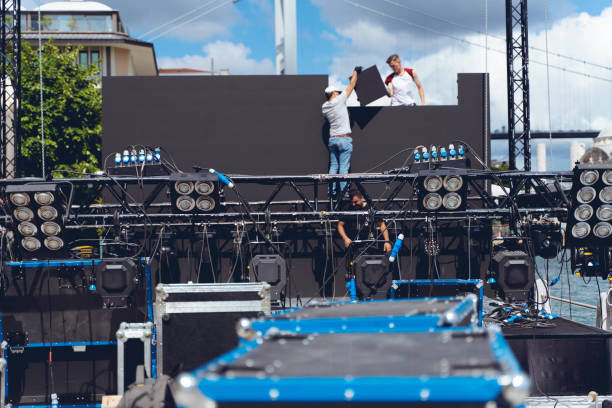In the world of stage productions, concert tours, and live events, lighting crews are the unsung heroes behind breathtaking visuals and smooth transitions. However, beyond creativity and technical know-how, safety must remain a top priority. This article outlines the essential lighting safety training tips for crews, covering physical setup, power management, fixture handling, fall protection, and emergency preparedness. Ensuring a culture of safety not only protects workers but also enhances overall production quality.
1. Understanding the Risks in Lighting Operations
Lighting work involves inherent risks—high voltages, elevated positions, heavy equipment, and rapid setup times. Proper training begins with understanding these dangers.
Electrical Hazards: Many lighting fixtures run on high voltage. Faulty wiring or poor insulation can lead to electric shocks or fires.
Rigging Accidents: Hanging lights from trusses or grids puts crew members at risk of falling objects or personal injury.
Thermal Exposure: Some lights generate significant heat, increasing the risk of burns or fires.
Trip Hazards: Loose cables across stage floors or backstage areas can easily become trip zones.
Training Tip: Conduct regular safety briefings to reinforce awareness of common hazards and review recent near-miss incidents.
2. Safe Fixture Handling and Installation
Handling lighting equipment requires both technique and caution. From unboxing to hoisting onto rigs, mishandling can result in equipment damage or personal injury.
Use Gloves: Heat-resistant gloves protect against hot fixtures and sharp edges.
Secure Mounting: Always double-check clamps and safety cables when mounting lights.
Balanced Lifting: Use proper lifting techniques or mechanical lifts for heavier fixtures.
Team Communication: Clear verbal cues during hoisting and mounting prevent missteps and accidents.
Training Tip: Integrate fixture mounting drills into onboarding programs and supervise during live rigging sessions.
3. Electrical Safety and Power Management
Improper electrical connections are a major source of risk. Crews must be trained on voltage compatibility, load distribution, and emergency shut-offs.
Label Circuits: Mark breakers and power sources clearly to avoid overload or confusion.
Test Continuity: Use a multimeter to verify all cables are intact before connection.
Use Grounded Plugs: Ensure all power equipment uses grounded and weather-rated plugs.
GFCI Devices: Employ Ground Fault Circuit Interrupters to cut power in case of abnormal current flow.
Training Tip: Train all crew members to perform pre-checks using test meters and visual inspections.

4. Working at Heights: Fall Protection and Safety Harnesses
Truss rigging and lighting grid access demand proper fall arrest procedures. Many injuries stem from improperly used or missing safety equipment.
Certified Harness Use: All riggers working above ground level should use fall arrest harnesses certified to local standards.
Inspection Protocol: Harnesses and lanyards should be inspected for frays, corrosion, and wear before every use.
Anchor Points: Use certified anchor points with suitable load ratings.
Buddy System: Never work alone at height; assign spotters or supervisors during rigging.
Training Tip: Include fall protection demonstrations in training, and refresh certifications annually.

5. Cable Management and Routing Techniques
Efficient cable management is not only aesthetic—it prevents trip hazards, equipment failures, and signal interference.
Label and Color Code: Use different colors or codes for DMX, power, and audio lines.
Use Cable Ramps: In walkways, secure cables using ramps to prevent damage or tripping.
Avoid Overlap: Power and data cables should not run together to prevent noise and interference.
Coil and Store Properly: Post-show routines should include proper coiling and dry storage to extend cable life.
Training Tip: Assign a “cable captain” per event to oversee neat routing and post-event storage.
6. Emergency Procedures and First Aid Preparedness
A proactive safety culture includes preparedness for worst-case scenarios.
Fire Extinguisher Access: Ensure extinguishers are nearby and that crew are trained to use them.
Emergency Shut-Off: Mark the main power cut-off switch for immediate access.
First Aid Kits: Fully stocked kits should be present in control areas and backstage zones.
Incident Logs: Maintain records of accidents or near-misses for continuous improvement.
Training Tip: Organize mock emergency drills—such as fire evacuations or shock response—every quarter.
7. Integrating Safety with Modern Technologies
New lighting systems often feature smart diagnostics and built-in safety functions. Training should include leveraging these tools.
Overheat Sensors: Train teams to interpret fixture warnings or auto-shutdowns.
Wireless Monitoring: Use apps and DMX controllers that alert for faults or anomalies.
Auto-shutoff Timers: Learn to configure time-based power cycles for night shutdown.
Training Tip: Stay updated with manufacturer training for the latest gear to utilize all built-in safety features.
Conclusion: Safety as a Continuous Process
Safety is not a one-time checklist—it's a mindset that must be nurtured and revisited regularly. Lighting crews operating in high-risk, fast-paced environments need comprehensive, ongoing training to remain vigilant. By establishing clear protocols, practicing regularly, and embracing technology, crews can ensure both their safety and the success of any performance.
READ MORE:





Blue Sea Lighting is an enterprise with rich experience in the integration of industry and trade in stage lighting and stage special effects related equipment. Its products include moving head lights, par lights, wall washer lights, logo gobo projector lights, power distributor, stage effects such as electronic fireworks machines, snow machines, smoke bubble machines, and related accessories such as light clamps.
Quick Links
For more questions subscribe to our email








